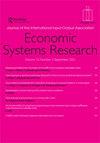将欧洲联盟的多部门经济模型和消费调查联系起来
IF 1.6
4区 经济学
Q2 ECONOMICS
引用次数: 11
摘要
多部门模式通常只有一个具有代表性的家庭。但是,需要更多样化的家庭类型来分析多种现象(即老龄化、性别不平等、收入分配影响等)的影响。家庭消费调查的微观数据为这类分析提供了丰富的数据源。然而,向多部门模型提供这类信息并不简单,最近的研究表明,即使是稍微不准确的程序也可能导致严重偏差的结果。本文介绍了将家庭消费微观数据输入宏观经济模型的完整程序,并首次系统地估计了将欧盟家庭预算调查的微观数据与最流行的多区域投入产出框架(例如欧盟统计局、世界经合组织、欧洲经委会、经合发组织)联系起来所需的桥梁矩阵。本文章由计算机程序翻译,如有差异,请以英文原文为准。
Linking multisectoral economic models and consumption surveys for the European Union
Multisectoral models usually have a single representative household. However, more diversity of household types is needed to analyse the effects of multiple phenomena (i.e. ageing, gender inequality, distributional income impact, etc.). Household consumption surveys’ microdata is a rich data source for these types of analysis. However, feeding multisectoral models with this type of information is not simple and recent studies show how even slightly inaccurate procedures might result in significantly biased results. This paper presents the full procedure for feeding household consumption microdata into macroeconomic models and for the first time provides in a systematic way an estimation of the bridge matrices needed to link European Union Household Budget Surveys’ microdata with the most popular multi-regional input–output frameworks (e.g. Eurostat, WIOD, EORA, OECD).
求助全文
通过发布文献求助,成功后即可免费获取论文全文。
去求助
来源期刊

Economic Systems Research
ECONOMICS-
CiteScore
5.60
自引率
4.00%
发文量
17
期刊介绍:
Economic Systems Research is a double blind peer-reviewed scientific journal dedicated to the furtherance of theoretical and factual knowledge about economic systems, structures and processes, and their change through time and space, at the subnational, national and international level. The journal contains sensible, matter-of-fact tools and data for modelling, policy analysis, planning and decision making in large economic environments. It promotes understanding in economic thinking and between theoretical schools of East and West, North and South.
 求助内容:
求助内容: 应助结果提醒方式:
应助结果提醒方式:


